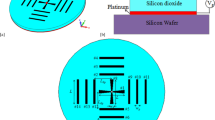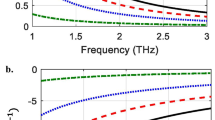Abstract
Large-distance communications beyond a few meters is challenging for Terahertz (THz) signals because of high spreading loss and absorption in the media. The smart antenna concept used for RF antennas to improve the signal-to-interference/noise level can be extended to these THz antennas. Out of the two types of implementations of this concept, viz. (i) adaptive array and (ii) switched-beam antenna, this paper presents the switched-beam nanoantenna for the THz wave region. Based on the Yagi-Uda antenna concept, switched-beam graphene nanoantennas over silicon dioxide (SiO2) substrate is proposed in this paper. In one case (Antenna-I), the antenna is able to switch the beam in ± 90º directions, whereas in the other case (Antenna-II), the switching directions are 0º, ± 90º, 180º. This pattern reconfigurability can also be observed over a frequency range leading to simultaneous pattern and frequency reconfigurable nature of the nanoantenna. The reconfigurability is obtained by changing the graphene conductivity through its chemical potential. Due to plasmonic wave propagation in graphene at THz, the proposed graphene nanoantenna resonates at a sub-wavelength scale. Design aspects and the working principle of switched-beam graphene plasmonic nanoantennas in the THz region are discussed in this paper.












Similar content being viewed by others
References
Cherry S (2004) Edholm’s law of bandwidth: telecommunications data rates are as predictable as Moore’s law. IEEE Spectr 41(7):58–60
Koch M (2007) Terahertz frequency detection and identification of materials and object, Nano Science for Peace and Security Series- B. Physics and Biophysics, edited by R. E Miles, X. C. Zhang, H. Eisele, and A. Krotkus, (Springer Science and Business Media, Dordrecht, Netherland), 325-338
Akyildiz IF, Jornet JM, Han C (2014) Terahertz band: next frontier for wireless communications. Physical Communication 12:16–32
Jornet JM, Akyildiz IF (2011) Channel modeling and capacity analysis for electromagnetic wireless nanonetworks in the terahertz band. IEEE Trans Wireless Commun 10(10):3211–3221
Tse D, Viswanath P (2005) Fundamentals of wireless communication. Cambridge Univ. Press, Cambridge, U.K.
Costantine BJ, Tawk Y, Barbin SE, Christodoulou CG (2015) Reconfigurable antennas: design and applications. Proc IEEE 103(3):424–437
Dash S, Patnaik A (2017) Material selection for THz antennas. Microw Opt Technol Lett 60(5):1183–1187
Dash S, Patnaik A (2018) Performance of graphene plasmonic antenna in comparison with their counterparts for low-Terahertz applications. Plasmonics 13(6):2353–2360
Jablan M, Buljan H, Soljacic M (2009) Plasmonics in graphene at infrared frequencies. Phys Rev B 80:245435
Iqbal T, Bibi S, Bashir A, Afsheen S (2021) Efficient excitation of novel graphene plasmons using grating coupling. Appl Nanosci
Iqbal T, Afsheen S (2016) Coupling efficiency of surface plasmon polaritons for 1D plasmonic gratings: role of under- and over-millinG. Plasmonics 11:1247–1256
Iqbal T (2018) Efficient excitation and amplification of the surface plasmons. Curr Appl Phys 18(11):1381–1387
Chen J et al (2019) Photonic microcavity-enhanced magnetic plasmon resonance of metamaterials for sensing applications. IEEE Photonics Technol Lett 31(2):113–116
Chen J et al (2019) Highly sensitive refractive-index sensor based on strong magnetic resonance in metamaterials. Appl Phys Express 12(5):052015
Chen J, Yang C, Gu P, Kuang Y, Tang C, Chen S, Liu Z (2021) High sensing properties of magnetic plasmon resonance by strong coupling in three-dimensional metamaterials. J Light wave Technol 39:562–565
Dash S, Patnaik A (2018) Graphene plasmonic bowtie antenna for UWB THz application. IEEE 24th National Conference on Communications (NCC) 2018, Hyderabad, India, 1–4
Ullah Z, Witjaksono G, Nawi I, Tansu N, Khattak MI, Junaid M (2020) A review on the development of tunable graphene nanoantennas for terahertz optoelectronic and plasmonic applications. Sensors 20(5):1401
Dash S, Patnaik A (2017) Dual-band reconfigurable plasmonic antenna using bilayer graphene. Proc. of IEEE International Symposium on Antennas and Propagation AP-S 2017, 921–922
Tamagnone M, Gómez-Díaz JS, Mosig JR, Perruisseau-Carrier J (2012) Reconfigurable THz plasmonic antenna concept using a graphene stack. Appl Phys Lett 101:214102
Dash S, Patnaik A, Kaushik BK (2019) Performance enhancement of graphene plasmonic nanoantenna for THz communication. IET Microwaves Antennas Propag 13(1):71–75
Dash S, Patnaik A (2017) Graphene loaded frequency reconfigurable metal antenna. 2017 IEEE International Conference on Antenna Innovations &Modern Technologies for Ground, Aircraft and Satellite Applications (iAIM 2017), Bangalore, 1–4
Correas-Serrano D, Gomez-Diaz JS (2017) Graphene-based antennas for terahertz systems: a review. Forum for Electromagnetic Research Methods and Application Technologies, arXiv: 1704.00371, 1–26
Yongle Wu, Meijun Qu, Jiao L, Liu Y, Ghassemlooy Z (2016) Graphene-based Yagi-Uda antenna with reconfigurable radiation patterns. AIP Adv 6:065308
Xu Z, Dong X, Bornemann J (2014) Design of a reconfigurable MIMO system for THz communications based on graphene antennas. IEEE Trans. on Terahertz Science and Technology. 4:609–617
Bolotina KI et al (2008) Ultrahigh electron mobility in suspended graphene. Solid State Commun 146(9–10):351–355
Novoselov K, Geim A, Morozov S, Jiang D, Grigorieva MIKIV, Dubonos S, Firsov A (2005) Two-dimensional gas of massless Dirac fermions in graphene. Nature 438:197–200
Balandin AA et al (2008) Superior thermal conductivity of single-layer graphene. Nano Lett 8:902–907
Lee C, Wei X, Kysar JW, Hone J (2008) Measurement of elastic properties and intrinsic strength of monolayer graphene. Science, 321(5887):385–388
Nair RR et al (2008) Fine structure constant defines visual transparency of graphene. Science 320(5881):1308–1308
Gusynin V, Sharapov S, Carbotte J (2006) Magneto-optical conductivity in graphene. J Phys Cond Matter 19(2):026222(1–28)
Zeng C, Liu XX, Wang G (2014) Electrically tunable graphene plasmonic quasicrystal metasurfaces for transformation optics. Sci Rep 4(5763):1–8
Dash S, Patnaik A (2021) Impact of silicon-based substrates on graphene THz antenna,Physica E: Low-dimensional Systems and Nanostructures. 126:114479
Gumi K, Ohno Y, Maehashi K, Inoue K, Matsumoto K (2012) Direct synthesis of graphene on SiO2 substrates by transfer-free processes. Jpn J Appl Phys 51:06FD12 (1–4)
CST - Computer Simulation Technology Studio Suite 2018 version
Tasolamprou AC et al (2019) Experimental demonstration of ultrafast THz modulation in a graphene-based thin film absorber through negative photoinduced conductivity. ACS Photonics 6:720–727
Akyildiz IF, Nie S, Lin S-C, Chandrasekaran M (2016) 5g roadmap: 10 key enabling technologies. Comput Netw 106:1748
Liaskos C, Nie S, Tsioliaridou A, Pitsillides A, Ioannidis S, Akyildiz IF (2018) A new wireless communication paradigm through software-controlled metasurfaces. IEEE Communication Magazine 56(9):162169
Dash S, Liaskos C, Akyildiz IF, Pitsillides A, “Wideband perfect absorption polarization insensitive reconfigurable graphene metasurface for THz wireless environment,”, (2019) IEEE Microwave Theory and Techniques in Wireless Communications (MTTW). Riga, Latvia 2019:93–96. https://doi.org/10.1109/MTTW.2019.8897231
Dash S, Liaskos C, Akyildiz IF, Pitsillides A (2020) Graphene hypersurface for manipulation of THz waves. Mater Sci Forum 1009:63–68
Chen J, Chen S, Gu P, Yan Z, Tang C, Xu Z, Liu B, Liu Z (2020) Electrically modulating and switching infrared absorption of monolayer graphene in metamaterials. Carbon 162:187–194
Funding
This research is supported by the Indian Space Research Organization (ISRO), India, through grant no. ISRO/RES/3/760/17–18, and partially via the European Union via the Horizon 2020: Future Emerging Topics—Research and Innovation Action call (FETOPEN-RIA), grant EU736876, project VISORSURF (http://www.visorsurf.eu).
Author information
Authors and Affiliations
Contributions
All authors contributed to the design and implementation of the research, analysis of the results, and the manuscript’s preparation.
Corresponding author
Ethics declarations
Consent to Participate
All authors agreed to participate in this research study.
Consent for Publication
Permission from all the authors has been taken to publish this manuscript.
Competing Interests
The authors declare no competing interests.
Additional information
Publisher's Note
Springer Nature remains neutral with regard to jurisdictional claims in published maps and institutional affiliations.
Rights and permissions
About this article
Cite this article
Dash, S., Soni, G., Patnaik, A. et al. Switched-Beam Graphene Plasmonic Nanoantenna in the Terahertz Wave Region. Plasmonics 16, 1855–1864 (2021). https://doi.org/10.1007/s11468-021-01449-y
Received:
Accepted:
Published:
Issue Date:
DOI: https://doi.org/10.1007/s11468-021-01449-y




